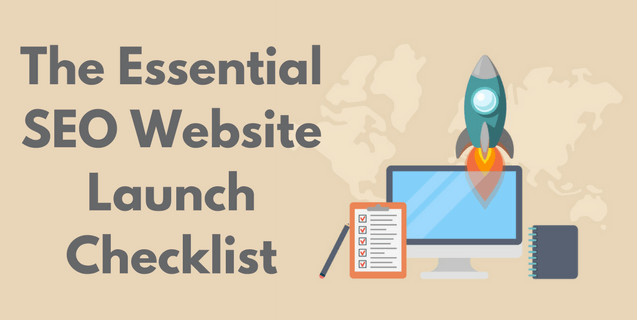
The Essential SEO Website Launch Checklist
Launching a new website is always a very tricky prospect from an SEO perspective. Without taking the proper steps and precautions, a launch has the potential to result in a dramatic loss of SEO rankings and traffic. It is essential to have a comprehensive SEO strategy and checklist for any website launch or re-design.
What are the key elements of a website launch checklist to avoid SEO pitfalls? The items below are core pieces of a launch support to identify potential risks pre-launch, uncover any lurking hazards, and ensure your launch goes smoothly.
Sit down, open a beer, and read away before hitting that magic “launch” button.
Site Crawling & Indexing
404 Response
When a bad URL is typed in, it’s important that your server returns an immediate 404 HTTP header response so Google doesn’t index or improperly assign value to invalid pages. Mishandling 404 pages can cause crawling issues, content duplication, and a poor user experience. As SEOs, you’re making sure 404s are not blocked, that they do not redirect to 2xx pages, or that 404s are not returning a 2xx HTTP status code.
Redirects
Redirects should seamlessly transfer users and search engine bots to the new location of any moved page. However, not all redirects are created equal. 301 permanent redirects will be preferred in most cases, 302s are temporary, and meta refresh redirects can cause some crawling issues. Also, avoid creating redirect chains. Make sure there is not a widespread or improper use of redirects because this can lead to mixed signals and a loss of page value.
Robots.txt
Robots.txt files block bots from crawling specific pages or directories on your website. Blocking improper files can lead to bad indexation, improper rendering, or potentially a loss of ranking. Ideally, you want to keep blocking to a minimum unless you’re experiencing server resource issues. Also check for proper syntax of the robots.txt file.
XML Sitemaps – Basics
When it comes to XML Sitemaps, you should be checking for two different things:
- The basics — Make sure the site has an XML sitemap or sitemaps, and that they appear to be functional and complete. While these are not required, they are an excellent crawling asset and diagnostic tool when used properly. XML sitemaps should include all live, indexable pages, no errors, and have 50K URLs or less.
- Configuration — Make sure the sitemap is configured and set up properly. Break the sitemap up into sections for larger sites.
HTTPS
Having a secure site (HTTPS) isn’t required, but Google is making an active push toward a more secure internet and awarding small boosts for secure sites. Proper configuration is key to make sure users don’t experience warnings, or duplicate content isn’t indexed. If a site uses HTTPS, make sure all other versions of the domain redirect properly to the preferred URLs.
Canonicalization
Canonical directives tell search engines, “there are multiple versions of this page/content, but this is the one I prefer you to show to users.” The strongest signals are 301 redirects with rel=”canonical” tags being a softer directive. Proper canonicalization helps Google and users to focus on the proper version of each page to encourage stronger ranking. This includes https/http, www/non-www and capitalized versions of URLs being handled appropriately.
Site Speed
How fast your server responds to visitors and renders the webpage is a critical element in both user-experience and organic ranking. Speed counts, and you want your website to be fast, especially with growing numbers of mobile users!
There are several different things to check for when it comes to managing site speed:
- Server Speed — Both users and bots love fast sites! The goal is to see server speed and load time around 2 seconds or less. Any higher than 4 seconds and something should be fixed.
- Page Size — The heavier the page, the more likely it is to load slowly which causes issues. The overall page size includes all elements, and the items most likely to cause issues are images and the scripts required to render a page. Ideally, you want to see pages under 1MB, but around 1-3MB is acceptable. Anything higher means there are opportunities for improvement.
- Image Size — More often than not, images tend to be the biggest culprit of bloated pages. Make sure images represent less than 60% of a pages total content size. Optimizing and compressing images can help immensely.
Site Structure
Information Architecture
The information architecture on your site can take many different strategies, but, overall, it should be logical and consistent. Subfolders should make sense to users, content silos should be clear, and all directories should resolve properly. A good IA can help with crawling, ranking of content/keyword groups and usability.
URL Structure
Your URLs are another tool in your organic ranking and usability arsenal. There are several different elements to check when it comes to URL:
- Keyword friendly — URLs that use friendly and concise keywords, without heavy use of internal naming/numbers or parameters, create a better user-experience and reinforce relevancy.
- Capitalization — Consistent naming standards and proper server handling of variations are important both for user-experience as well as for funneling all potential value for a single page to its preferred version.
- Dashes vs. Underscores — Readability in URLs is key. Keywords should be separated- the preferred industry standard is to use dashes (-). Underscores (_) can be difficult to see as URLs are generally shown as underlined text.
Pagination
If you have pages that occur in a series, whether as part of a category or multiple pages of a single article, properly using the pagination rel tags helps search engines to understand the series and present them in proper order in the SERPs to users. Pagination is especially important on blog pages!
Breadcrumbs
In addition to standard navigation, visible and logical breadcrumbs on every page are a great navigational tool for users, especially on mobile and tablet devices. Further, properly structured data markup and consistent structure could encourage the display of breadcrumbs in the SERPs.
Mobile Friendliness
Google’s public mobile-friendly test is a great first start to understanding how Google sees your site as mobile friendly, but it doesn’t go deep and is a page-by-page basis (i.e., not sitewide). While you want to see your site pass, keep in mind that a passing score here can still mean you have other errors or warnings to address before you are fully mobile optimized.
Content Tags
Structured Data Markup
Structured data is a special markup for specific elements that can help search engines better understand your website and increase the chance of rich snippets showing in the SERPs for your website. Google supports rich snippets for many items such as reviews, people, products, businesses/organizations, recipes, events and music, breadcrumbs, and more.
Title Tags
The page title element of a web page is meant to be an accurate and concise description of a page’s content. This element is critical to both user experience and search engine optimization. Title tags should be unique per page, focus on the value of the page by using targeted keywords, and be roughly 50-60 characters, including spaces.
Meta Descriptions
Meta descriptions may have no direct effect on rankings; however, they are still important as they appear in the SERPs as the page description and can influence click through rate which is an indirect ranking factor. The meta description should include targeted keywords, but more importantly, it ought to convey a marketing message designed to generate a click. Metas should optimally be no more than 160 characters.
Header Tags
H1 tags should be used as the main headline of the page. There should only be one H1 tag used in the main header that introduces, or highlights, the topic and opening paragraph of the page. Subsequent H2-H6 tags should be used to outline other important information on the page.
Day of Launch Checks
It’s here! Launch day! All the prep leading up to this day has been completed, and your new site is finally live. It may be easy to just push the button and forget about it, but stop right there! You are not done with your website launch checklist – there are still some items to check off.
- Check site indexing and crawling – did you remove ‘noindex’ tags?
- Check 301 Redirects – are they working?
- 404 Errors – These usually take longer to process for pages on a new site, but check for 404s on the old site where 301s may not be working or were missed.
- Resubmit XML Sitemap
- Check Google Analytics (GA) tracking
- Update GA Goals
Launching a new website and want some SEO help from the team of experts at Volume Nine? Or want to just learn more about our website launch checklist? Contact us today!







